Print version of this lesson plan. Note: Readings, maps and photos can be found in the pdf version of the lesson plan.
About this lesson
This lesson was written by Dr. James Perez Viernes, the Outreach Director and Associate Professor of the Center for Pacific Islands Studies at the University of Hawai‘i at Mānoa. It was edited by the Guampedia editorial staff. This lesson is one in a series that brings the important stories of historic places into classrooms across the country [Note: Modifications are based on the National Park Service’s History Methods: Teaching with Historic Places Resource Guide, 2015].
Subjects
The lesson can be used in middle and high school units relating to Guam History, Spanish Colonization, American Expansionism, Globalization, Cultural Imperialism, and Architecture, Guam/Pacific/World History, Social Studies, Anthropology, CHamoru Studies, Micronesian Studies, Pacific Islands Studies
Grade-level
Middle and High school students who have completed basic geography and social studies classes.
Time required
In-class: 6.5 hours
Independent study: 4-6 weeks
Materials required
The readings and maps listed below can either be used directly on the computer or can be printed out, photocopied and distributed to students.
- Four readings: The first provides information about the National Historic Preservation Act (1966); the second is a description of Sumai/Sumay and its history, and the memory of the people who lived there prior to World War II; the third is an overview of Guampedia’s project on remembering Guam’s cultural and historic heritage sites.
- Two maps: The first is a modern map of Guam; the second is a map of Guam prior to World War II.
- Two photos: The first is the now destroyed Catholic church of Sumai, Our Lady of Guadalupe; the second is of two residents of Sumai who share their personal insights on the significance of Sumai prior to World War II and today.
- Students should have access to the following equipment:
- Camera with both still-image and video recording capabilities
- Materials for recording information (i.e., notebook, pens, sound recorder, etc.)
- Access to computer with word processing and presentation software (i.e., PowerPoint, Prezi, etc.)
- Thumb drive, external hard drive, etc.
Related background film viewing
Hasso’: I Guinahan Guahan, Guam’s Unique Sense of Place. Guampedia Foundation. 2015.
Related background reading
- Babauta, Leo. Sumai. Retrieved 27 November 2020.
- Carson, Mike. Ritidian (Litekyan). Retrieved 27 November 2020.
- Tolentino, Dominica. Hasso’: Remembering Guam’s Ancient Heritage Sites. Retrieved 27 November 2020.
- Viernes, James. Sumay: Rikuetdo para i Famagu’on-ta. A Legacy for our Children. Sånta Rita-Sumai, Guam.
Related links
Related resources
- Micronesian Areas Research Center, University of Guam
- Robert F. Kennedy Library, University of Guam
- Nieves Flores Public Library, Hagåtña, Guam
Lesson Plan
Description
This film project encourages students to deeply engage with Guam’s cultural heritage by visiting the island’s historic sites, talking to people, and using various resources to gather information about places with cultural or historic significance in Guam. In addition, students will be able to critically discuss issues surrounding historic sites and the importance of historic preservation.
Objectives/Skills
Through this project, students will:
- Be able to identify and locate Guam’s historic sites and structures.
- Demonstrate in oral, written, and visual forms their knowledge of historical and cultural heritage sites, including their background, their significance to people today, and current efforts or needs to preserve/perpetuate them.
- Students will demonstrate knowledge of the overall significance to understanding historical, cultural, political, and social issues and concerns related to historic sites in Guam.
- Develop the ability to locate, interpret and evaluate scholarly and other sources and make meaningful and critical connections between such material and the specific sites that they visit.
- Enhance familiarity and skill base in multimedia technology.
- Expand public speaking and presentation skills.
In-class Procedure
Day 1
Reading 1: What is Historic Preservation?
- Announce to the students: “The year is 3016 – one thousand years from now. We’re long gone, and so are most of the things around us.”
- Ask the students the following questions:
- “What do you think people will remember about the world of 2016?”
- “Do you think they will understand what daily life was like for us?”
- “If we could send them a package of items to help them understand, what would we include?” (Write brainstorming ideas on the board.)
- Ask students to explain the items they have chosen for people to remember 2016. Why are these items important or significant? Explain how these items relate to an understanding of their world, themselves, their culture, their society in the present as well as in the past.
- Turn the discussion to historic preservation. Ask, “What is historic preservation?” and write some of their ideas on the board.
- Present students with Reading 1: What is Historic Preservation? / The National Historic Preservation Act (1966). Read through “What is Historic Preservation?” first and discuss by comparing their responses prior to the reading with the NPS definition.
- Questions for Reading 1:
- What, do you think, would be an example of something on Guam that would fall under the protection of the National Historic Preservation Act?
- What other challenges might prevent a historic place from being saved or preserved?
- Say to the students, “For the next few weeks, we’re going to learn about historic preservation, and you will take on the role of preservationist–a person who tries to preserve or record or document historical or cultural artifacts from the past or present, so that they won’t be forgotten. You will document a historic place and talk to people so you can learn what it is about that place that makes it significant for Guam, and why it should be protected. As you’ll see, preserving something historically or culturally important is not always easy.”
- Introduce students to the National Historic Preservation Act, by referring them again to Reading 1.
- Discuss the questions for Reading 1. Have students offer three examples of what they believe are historic sites on Guam. Ask the students who offered the examples to explain why they consider them historically or culturally significant. Based on these responses, allow the class to take a vote for each site offered over whether they should or should not be preserved under the Historic Preservation Act.
Day 2
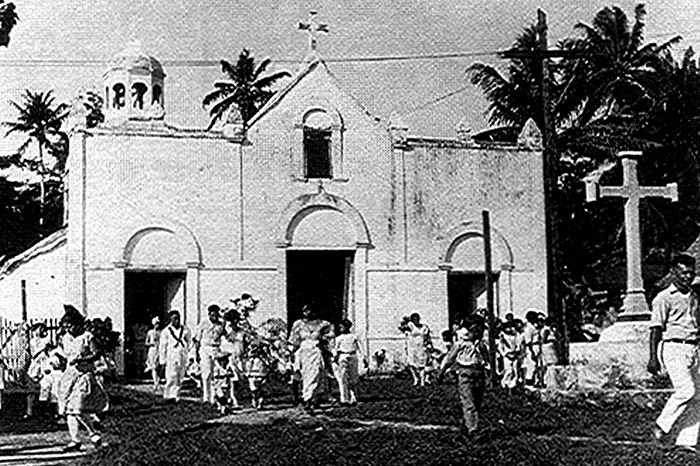
Questions
- What type of building is this?
- How was this building used?
Teaching Activities
- Present students with Photo 1: Image of the Catholic church in Sumai (Photo courtesy of Don Farrell, p. 17, from Sumay: A Legacy for our Children, by James Viernes).
- Discuss and answer the following questions as a class:
- Step 1: Examine the photograph for 10 seconds. How would you describe the photograph?
- Step 2: Divide the photograph into quadrants and study each section individually. What details – such as people, objects, and activities – do you notice?
- Step 3: What other information (such as time period, location, season, reason photo was taken) can you gather from the photo?
- Step 4: How would you revise your first description of the photo using the information noted in Steps 2 and 3?
- Step 5: What questions do you have about the photograph? How might you find answers to these questions?
- Step 6: Does this Church still exist? How did you reach this conclusion?
- Inform students that this building was the Catholic church in the village of Sumai in southern Guam. The church was named in honor of Our Lady of Guadalupe. Ask students to raise their hand if:
- They have heard of Sumai.
- They know where Sumai is located.
- They have heard of Our Lady of Guadalupe Church.
- They know where Our Lady of Guadalupe Church is located today.
- Inform students that Sumai is located within Naval Station. Explain that Sumai is no longer a major village of Guam and all that remains in tact is the cemetery. Explain that the residents were moved after World War II to form a new village called Sånta Rita-Sumai, which is where Our Lady of Guadalupe Church is located today.
Setting the stage
Babauta, Leo. Sumai. Retrieved 27 November 2020.
Locating the site

War in the Pacific National Historical Park
Questions for Map 1
- Where is Sumai located on the map?
- Why, do you think, the Spanish felt this was an ideal location to install forts and guns to protect the island?
- What kinds of activities do you think the people of Sumai participated in? How, do you think, Sumai may have differed from Hagåtña?
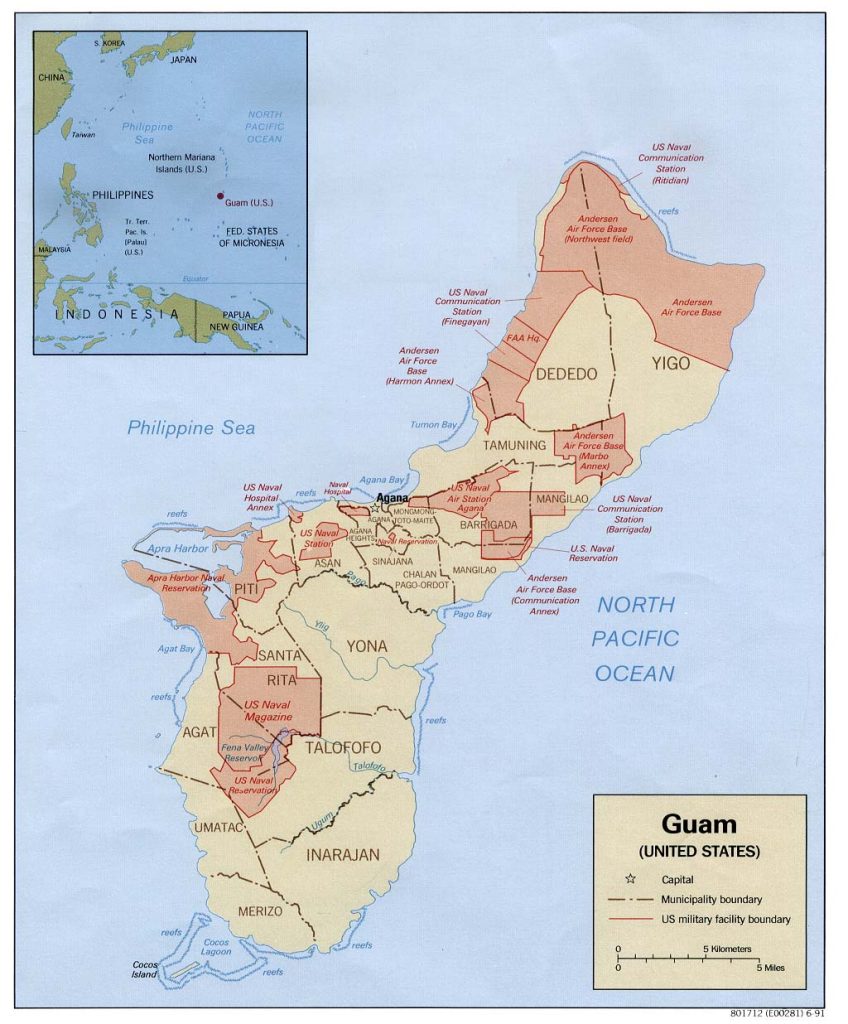
Questions for Map 2
- Where is Sumai located on the map?
- Why, do you think, the Navy kept the land and did not allow the residents to return to Sumai and their way of life?
- How, do you think, the residents of Sumai felt about having to move away?
Determining the facts
Reading 2: “Sumay: A Legacy for Our Children”
Viernes, James. Sumay: Rikuetdo para i Famagu’on-ta. A Legacy for our Children. Sånta Rita-Sumai, Guam: Guam Preservation Trust. 2013.
Questions for Reading 2
- What was life in Sumai like before World War II broke out in Guam?
- Why, do you think, the people of Sumai after World War II ended, wanted to return to Sumai after it had been destroyed?
- Had it been in existence then, could the National Historic Preservation Act have saved the village of Sumai? Explain your answer.
- If your home town had been destroyed through some kind of natural disaster or the tragedy of war, what would you remember about your home town? How would you like your home town to be remembered by others who had never visited it or knew it existed?
Photo 2: Sumai Survivors
Viernes, James. Sumay: Rikuetdo para i Famagu’on-ta. A Legacy for our Children. Sånta Rita-Sumai, Guam: Guam Preservation Trust. 2013.
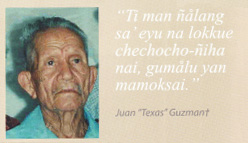
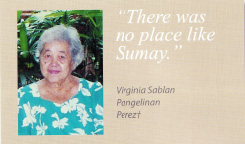
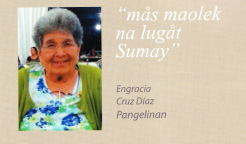
Film Session 1
Hasso’: I Guinahan Guahan, Guam’s Unique Sense of Place
Reading 3
Tolentino, Dominica. Hasso’: Remembering Guam’s Ancient Heritage Sites. Retrieved 27 November 2020.
- Before class, have students read “Hasso’: Remembering Guam’s Heritage Sites” on Guampedia.com or in the handout, to provide a background for the film.
- Have students view “Hasso’” film in class (about 40 minutes).
- After students have viewed the film, have them get into the groups of 4 to 5. Instruct students to share their initial reactions to the film and any questions they might have about specific content.
- Instruct students to gather their thoughts on the three questions posed in the film associated with the challenges facing the people of Guam in preserving historical/heritage sites:
- How could the people of Guam or those interested ancient CHamoru culture be able to see these sites when they are no longer accessible? What factors lend to their inaccessibility?
- How could people be taught the importance of cultural preservation and respect, especially of heritage sites?
- How could increasing knowledge of Guam’s heritage sites protect these sites from destruction or desecration by both manmade and natural forces?
- After students have had a good amount of time to discuss the above questions, go around and sit with each group for about 5 minutes each and jump into the discussion or help facilitate it if group is having difficulties.
- Prior to dismissing class, instruct them to prepare to share their answers from the day’s discussion with the rest of the class or during the next class session, if needed.
- By now, students should have a good understanding of historic preservation and some of the issues surrounding the identification, appreciation and protection of historic and cultural sites.
- Inform students that they will next be engaged in a film documenting project of a historic site on Guam. The groups they formed during the Hasso’ film discussion will work together to complete the project. Allow students time to exchange and share contact information and phone numbers/email addresses.
Film Session 2
Historical and Cultural Sites Film Project
- Begin class with a large group discussion in which the smaller groups each share their responses to the previous day’s viewing of Hasso’. Facilitate the larger discussion by comparing similarities and differences between group responses.
- How do current efforts at heritage site preservation contribute to addressing the problems outlined in the articles?
- What challenges remain in Guam for the ongoing effort to preserve cultural and historical sites?
- Have students get into their assigned groups and distribute the attached handout (Group Project Guidelines).
- Review the Project Guidelines handout carefully with students. Answer any questions or address any concerns about the project.
Independent Study
Students should be given 4 to 6 weeks to complete the project after three days of classroom instruction related to the project.
At a midway point on the project timeline, they should meet as a group with the instructor to evaluate the progress of the project, address any problems, and to seek guidance, support, advice from the instructor.
When project is done, two days of class time should be reserved for students to present their film projects to the class, where the project will be open to questions, comments, and criticism.
